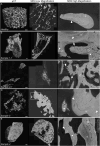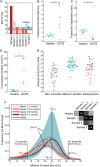Denosumab treatment of giant cell tumors in the spine induces woven bone formation
- PMID: 40390810
- PMCID: PMC12087960
- DOI: 10.1093/jbmrpl/ziaf063
Denosumab treatment of giant cell tumors in the spine induces woven bone formation
Abstract
Giant cell tumors of bone (GCTB) are rare but aggressive, locally destructive tumors. They typically affect young people, significantly reducing their quality of life and increasing mortality rates. Giant cell tumors of bone are composed of osteoclast-like giant cells that respond to increased secretion of RANKL by stromal cells, triggering osteolysis. For over a decade, denosumab, a monoclonal antibody targeting this receptor activator, has been approved as a neo-adjuvant to facilitate surgical resection or in the setting of inoperable tumors. Denosumab treatment has shown rapid pain improvement and tumor size reduction in the spine. Although variable degrees of tumor mineralization have been observed in clinical applications of this drug, the nature of this newly formed mineralized tissue has yet to be determined. To characterize both mineralization and collagen organization in the newly formed bone, we conducted extensive analyses on 4 posttreatment giant cell tumor vertebral samples, involving quantitative backscattered imaging, electron probe microanalysis, and a novel method for determining the alignment of collagen fibrils using second harmonic generation. Additionally, biological mechanisms involved in bone mineralization and matrix formation were analyzed using histological staining and mass spectroscopy. Our results concluded that denosumab treatment after giant cell tumor of bone in the spine was associated with the formation of woven bone and increased mineral density in a matrix of disorganized collagen fibers characterized by increased collagen III content, with the response appearing to depend on patient age and extension of treatment. To our knowledge, this is the first comprehensive material-based study on the bone formed during denosumab treatment for GCTB, providing valuable information on how denosumab affects bone quality and how the reported methodology can be applied to similar studies.
Keywords: bone microscopy; bone mineralization; denosumab; giant cell tumor; spine; woven bone.
© The Author(s) 2025. Published by Oxford University Press on behalf of the American Society for Bone and Mineral Research.
Conflict of interest statement
R.C.M has received research support from a 2024 AOSpine Knowledge Forum Associate Research Award, AOSpine, the Canadian Orthopaedic Foundation, a 2023 NASS translational award, a 2023 New Frontiers in Research Exploration Award, a 2023 Vancouver Coastal Health Research Institute Investigator Award, and a 2022 AOSpine DIA, they serve on the advisory board for Cerapedics Education Event as a co-chair, is co-chairing a Stryker educational event, and a CarboFix-joint solutions educational event. N.D. has been a consultant for Baxter, Cerapedics, and Stryker, owns stock in Medtronic, and has fellowship support paid to their institution from AOSpine, Medtronic, and Depuy Synthes. C.F. has been a consultant for Medtronic, is awarded royalties from Medtronic, and has fellowship support paid to their institution from AOSpine, Medtronic, and Depuy Synthes.
Figures







Similar articles
-
Denosumab induces tumor reduction and bone formation in patients with giant-cell tumor of bone.Clin Cancer Res. 2012 Aug 15;18(16):4415-24. doi: 10.1158/1078-0432.CCR-12-0578. Epub 2012 Jun 18. Clin Cancer Res. 2012. PMID: 22711702 Clinical Trial.
-
Is a Short-course of Preoperative Denosumab as Effective as Prolonged Therapy for Giant Cell Tumor of Bone?Clin Orthop Relat Res. 2020 Nov;478(11):2522-2533. doi: 10.1097/CORR.0000000000001285. Clin Orthop Relat Res. 2020. PMID: 32401001 Free PMC article.
-
Giant cell tumor of the thoracic spine completely removed by total spondylectomy after neoadjuvant denosumab therapy.Eur Spine J. 2017 May;26(Suppl 1):236-242. doi: 10.1007/s00586-017-5086-7. Epub 2017 Apr 10. Eur Spine J. 2017. PMID: 28396950
-
Preoperative Denosumab plus Surgery in the Management of Giant Cell Tumor of Bone: A Comprehensive Narrative Literature Review.Gulf J Oncolog. 2019 May;1(30):67-75. Gulf J Oncolog. 2019. PMID: 31242985 Review.
-
The risk of neurological deterioration while using neoadjuvant denosumab on patients with giant cell tumor of the spine presenting with epidural disease: a meta-analysis of the literature.Spine J. 2024 Jun;24(6):1056-1064. doi: 10.1016/j.spinee.2024.01.016. Epub 2024 Jan 30. Spine J. 2024. PMID: 38301904 Review.
Cited by
-
18F-FDG PET/CT revealed primary malignant giant cell tumor of the sacrum: a case report.Front Med (Lausanne). 2025 Aug 15;12:1653522. doi: 10.3389/fmed.2025.1653522. eCollection 2025. Front Med (Lausanne). 2025. PMID: 40893884 Free PMC article.
References
LinkOut - more resources
Full Text Sources

